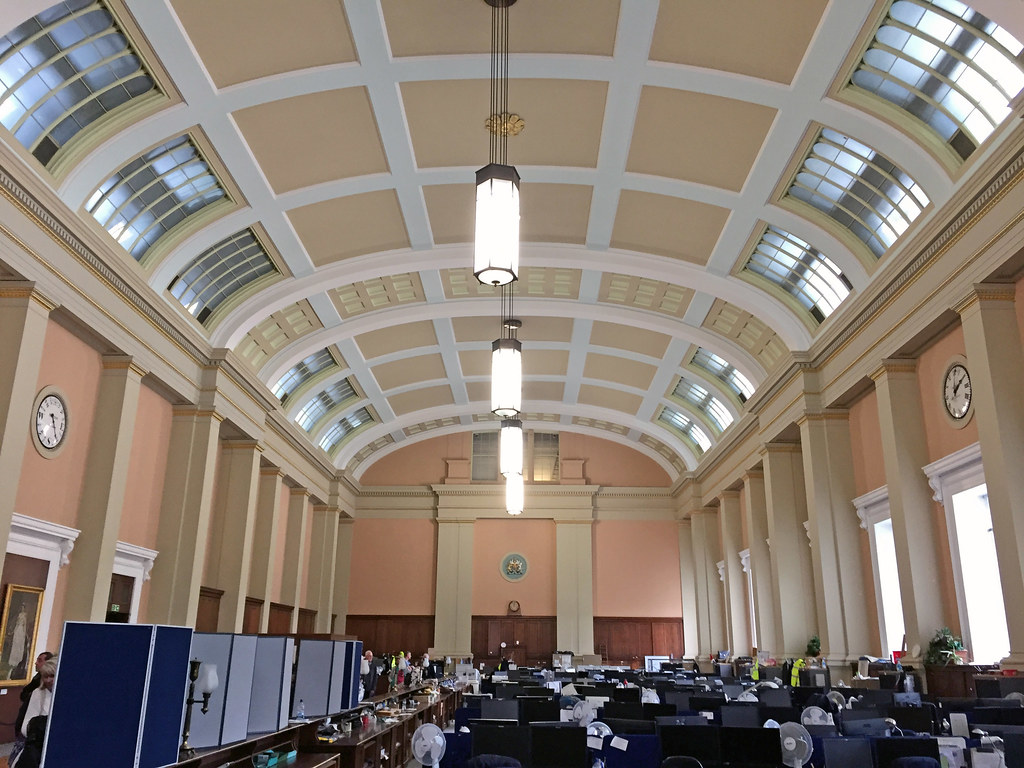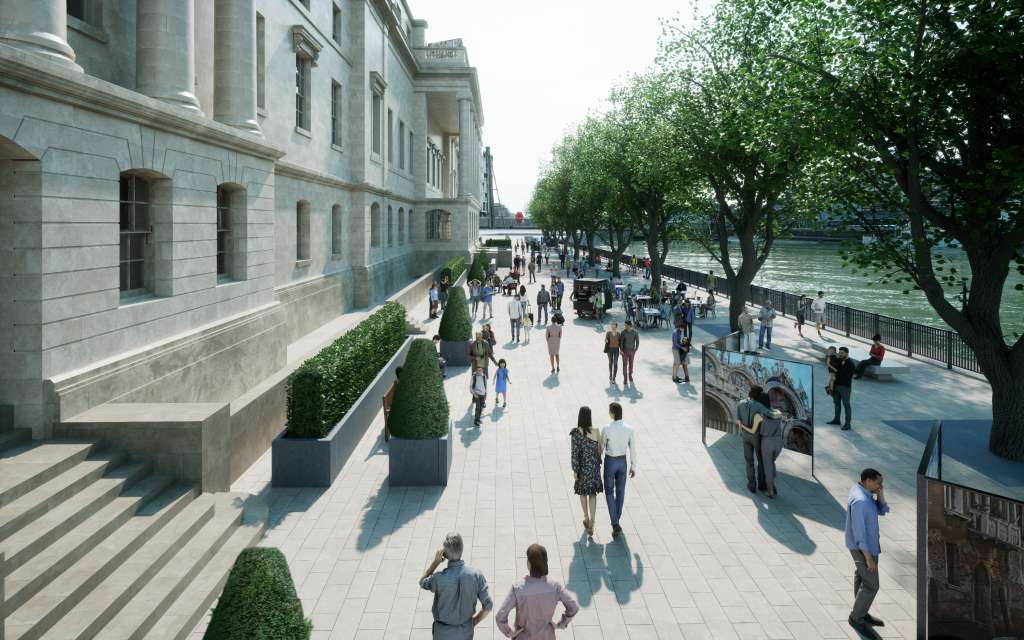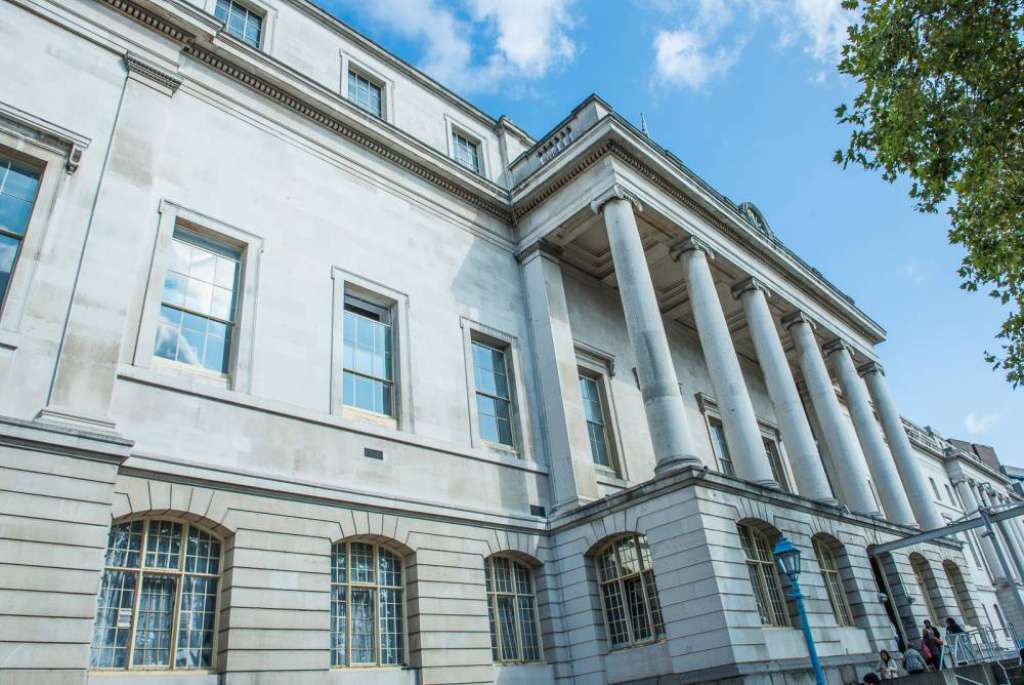PRESS RELEASE: Future of palatial Thames landmark in the balance as public inquiry opens
1st February 2022
The public inquiry into highly controversial plans to convert and extend London’s Custom House has opened in the City of London. The inquiry is examining a series of issues arising from proposals to convert the 19th century landmark on the banks of the Thames into a 200-room hotel.
Two key issues under examination are the impact of the proposed hotel conversion and extension on the historic significance of the building and the lack of public access proposed, particularly permanent guaranteed access to the beautiful Riverside Terrace. SAVE’s main concern is that the proposed hotel scheme will not provide the degree and perpetuity of public access that are necessary to preserve the significance of the heritage asset which derives so greatly from its historic public use.
Public access to the Custom House’s interior (including the Long Room) and to the broad Riverside Terrace is critical to securing the City Corporation’s vision for regenerating the Riverside. In our view the current proposals do not provide adequate permanent unencumbered public access to the interior or to the Riverside Terrace. The potential requirements of the hotel for private and exclusive events appear to take precedent over public access. SAVE has been campaigning on this issue since the plans were unveiled in October 2020. See our previous press releases here.
SAVE Britain’s Heritage has submitted a detailed statement to the inquiry by heritage and conservation expert Alec Forshaw. Our statement reiterated our concern that public access to the Custom House is critical to protecting its historic significance and future use. “The Custom House is one of London’s great public buildings, of national and international importance. SAVE agrees with other objectors that the current proposals harm the historic fabric and appearance of the building…but our main concern is that the scheme does not provide adequate secure, permanent, inclusive and unfettered public access. The harm caused far outweighs the public benefits offered.” See the full SAVE submission here.
We are supporting The Georgian Group’s alternative proposals for reusing the building, which focus on protecting the buildings historic fabric and plan form, as well as and prioritising full and unfettered public access. The scheme proposes a mixture of office spaces in the eastern and western wings, with public exhibition spaces in the central body, including the grand 190ft Long Room. See visualisations of this alternative scheme here
The Georgian Group is fundraising towards their costs at the public inquiry. Their Just Giving page is here for more details.
The inquiry, which opened on the 25th January and is set to conclude on Friday 11th February 2022, is being held at the Guildhall, presided over by Planning Inspector Paul Griffiths on behalf of the Secretary of State, Michael Gove, who will make the final decision on the scheme later this year.
Representing the City Corporation in opposing the scheme is Neil Cameron QC, with Dr Nigel Barker Mills giving evidence on the heritage, design and townscape impacts of the proposed hotel conversion. Representing the Georgian Group alongside the Corporation is barrister Matthew Henderson, with Neil Burton giving evidence on heritage issues.
On the opposing side, co-applicants Cannon Capital Developments Ltd & Global Gem Hotels Ltd, whose appeal against the City of London Corporation triggered the inquiry, are being represented by Russell Harris QC, with heritage evidence being given by Dr Chris Miele of Montague Evans and Stephen Levrant of Stephen Levrant Heritage Architecture.
History of The Custom House
The Custom House has served for hundreds of years as the headquarters of HM Customs and Excise, a government organisation with its own romantic and often secret history of fast-moving cutters, intercepting pirates and smugglers stretching back to the 1690s. HM Customs claims to be the oldest law enforcement agency in the world, with the first recorded Customs Duty dating from 743AD.
A custom house has stood on this site since medieval times. The Elizabethan Custom House, dating from 1559, was built of redbrick with octagonal towers reminiscent of St James’s Palace. Destroyed in the Great Fire of London in 1666, it was the first building King Charles II proposed for rebuilding, giving the great Sir Christopher Wren his first commission in London.
Wren’s superb building, which contained a magnificent long room, was gutted by a savage fire and was rebuilt by Thomas Ripley in 1718-25, but was destroyed again by fire in 1814. Fire was a constant danger due to the flammable goods (often confiscated) stored in the building, most notably gunpowder and spirits.
In 1817, rebuilding was entrusted to David Laing, a pupil of Sir John Soane (architect of the Bank of England), who produced a magnificent folio volume illustrating his grandiose plans. However, his failure to supervise the contractor resulted in one of the great corruption scandals of the age and destroyed Laing’s reputation.
In 1825, seven years after completion, the centre of the façade collapsed, bringing down a large part of the Long Room including Laing’s elegant saucer-domed ceiling.
The centrepiece was then rebuilt by Sir Robert Smirke, architect of the British Museum, with Ionic columns and a barrel-vaulted Long Room behind. Rows of customs clerks would deal with merchants, ships' captains and brokers in clearing goods and ensuring tariffs were safely collected.
In 2001, the Custom House was included in the Mapeley STEPS PFI deal, which saw around two thirds of the UK tax and customs estate sold off to a Bermuda based property company for £370m, and then leased back to the government under a 20 year agreement.
ENDS
1. Read SAVE’s full submission to the Inquiry here.
2. See here for our previous press release from October 2021.
3. See SAVE’s alternative scheme by John Burrell from October 2020 here.
4. See here for the article published in The Times by Richard Morrison on 29th October 2021.
5. For more information contact SAVE Britain's Heritage at office@savebritainsheritage.orgor 020 7253 3500.
6. SAVE Britain’s Heritage is a strong, independent voice in conservation that fights for threatened historic buildings and sustainable reuses. We stand apart from other organisations by bringing together architects, engineers, planners and investors to offer viable alternative proposals. Where necessary, and with expert advice, we take legal action to prevent major and needless losses.





